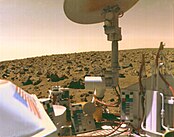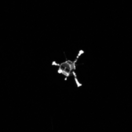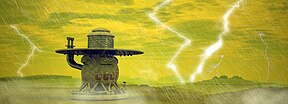
Back مركبة إنزال Arabic Aterrizador AST Enmə aparatı Azerbaijani انمه آپاراتی AZB Пасадачны модуль Byelorussian Спускаем модул Bulgarian অবতরণ যান Bengali/Bangla Lender (svemirska letjelica) BS Mòdul de descens Catalan Přistávací modul Czech
This article needs additional citations for verification. (September 2020) |
This article needs to be updated. (August 2023) |
A lander is a spacecraft that descends towards, then comes to rest on the surface of an astronomical body other than Earth.[1][page needed] In contrast to an impact probe, which makes a hard landing that damages or destroys the probe upon reaching the surface, a lander makes a soft landing after which the probe remains functional.
For bodies with atmospheres, the landing occurs after atmospheric entry. In these cases, landers may employ parachutes to slow them down enough to maintain a low terminal velocity. In some cases, small landing rockets will be fired just before impact in order to reduce the lander's velocity. Landing may be accomplished by controlled descent and set down on landing gear, with the possible addition of a post-landing attachment mechanism (such as the mechanism used by Philae) for celestial bodies with low gravity. Some missions (for example, Luna 9 and Mars Pathfinder) used inflatable airbags to cushion the lander's impact rather than utilizing more traditional landing gear.
When a high-velocity impact is intentionally planned in order to study the consequences of impact, the spacecraft is called an impactor.[2]
Several terrestrial bodies have been subject to lander or impactor exploration. Among them are Earth's Moon; the planets Venus, Mars, and Mercury; Saturn's moon Titan; asteroids; and comets.
- ^ Ball, Andrew; Garry, James; Lorenz, Ralph; Kerzhanovich, Viktor (May 2007). Planetary Landers and Entry Probes. Cambridge University Press. Bibcode:2007plep.book.....B. ISBN 978-0-521-82002-8.
- ^ Davis, Phil; Munsell, Kirk (23 January 2009). "Technology – Impactor – The Plan". Deep Impact Legacy Site (archive). NASA/JPL. Archived from the original on 26 April 2009. Retrieved 22 April 2009.
© MMXXIII Rich X Search. We shall prevail. All rights reserved. Rich X Search






